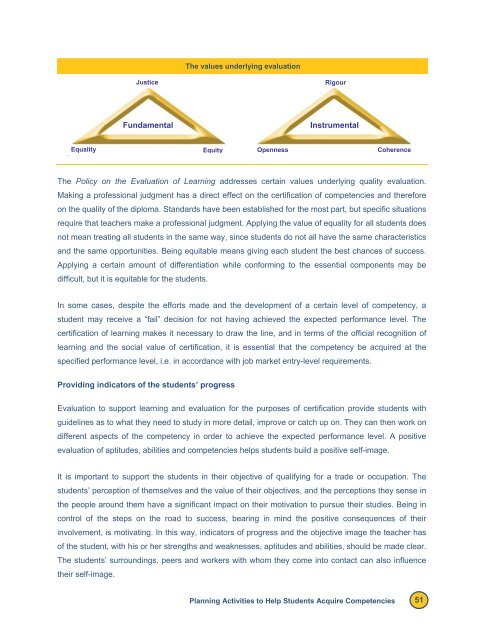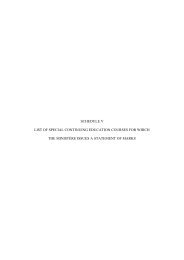Reference Framework for Planning Learning and Evaluation Activities
Reference Framework for Planning Learning and Evaluation Activities
Reference Framework for Planning Learning and Evaluation Activities
Create successful ePaper yourself
Turn your PDF publications into a flip-book with our unique Google optimized e-Paper software.
The values underlying evaluation<br />
Justice<br />
Rigour<br />
Fundamental<br />
Instrumental<br />
Equality<br />
Equity<br />
Openness<br />
Openness<br />
Coherence<br />
The Policy on the <strong>Evaluation</strong> of <strong>Learning</strong> addresses certain values underlying quality evaluation.<br />
Making a professional judgment has a direct effect on the certification of competencies <strong>and</strong> there<strong>for</strong>e<br />
on the quality of the diploma. St<strong>and</strong>ards have been established <strong>for</strong> the most part, but specific situations<br />
require that teachers make a professional judgment. Applying the value of equality <strong>for</strong> all students does<br />
not mean treating all students in the same way, since students do not all have the same characteristics<br />
<strong>and</strong> the same opportunities. Being equitable means giving each student the best chances of success.<br />
Applying a certain amount of differentiation while con<strong>for</strong>ming to the essential components may be<br />
difficult, but it is equitable <strong>for</strong> the students.<br />
In some cases, despite the ef<strong>for</strong>ts made <strong>and</strong> the development of a certain level of competency, a<br />
student may receive a “fail” decision <strong>for</strong> not having achieved the expected per<strong>for</strong>mance level. The<br />
certification of learning makes it necessary to draw the line, <strong>and</strong> in terms of the official recognition of<br />
learning <strong>and</strong> the social value of certification, it is essential that the competency be acquired at the<br />
specified per<strong>for</strong>mance level, i.e. in accordance with job market entry-level requirements.<br />
Providing indicators of the students’ progress<br />
<strong>Evaluation</strong> to support learning <strong>and</strong> evaluation <strong>for</strong> the purposes of certification provide students with<br />
guidelines as to what they need to study in more detail, improve or catch up on. They can then work on<br />
different aspects of the competency in order to achieve the expected per<strong>for</strong>mance level. A positive<br />
evaluation of aptitudes, abilities <strong>and</strong> competencies helps students build a positive self-image.<br />
It is important to support the students in their objective of qualifying <strong>for</strong> a trade or occupation. The<br />
students’ perception of themselves <strong>and</strong> the value of their objectives, <strong>and</strong> the perceptions they sense in<br />
the people around them have a significant impact on their motivation to pursue their studies. Being in<br />
control of the steps on the road to success, bearing in mind the positive consequences of their<br />
involvement, is motivating. In this way, indicators of progress <strong>and</strong> the objective image the teacher has<br />
of the student, with his or her strengths <strong>and</strong> weaknesses, aptitudes <strong>and</strong> abilities, should be made clear.<br />
The students’ surroundings, peers <strong>and</strong> workers with whom they come into contact can also influence<br />
their self-image.<br />
<strong>Planning</strong> <strong>Activities</strong> to Help Students Acquire Competencies 51




